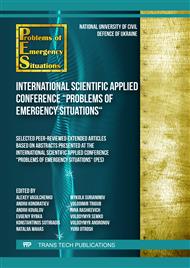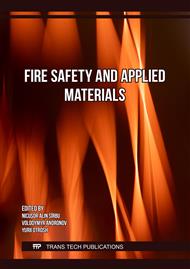[1]
N. Sytnik et al., Determination of the influence of natural antioxidant concentrations on the shelf life of sunflower oil, Eastern-European Journal of Enterprise Technologies, 4/11 (106) (2020) 55–82.
DOI: 10.15587/1729-4061.2020.209000
Google Scholar
[2]
V. Andronov et al., Efficiency of utilization of vibration-absorbing polimer coating for reducing local vibration, Naukovyi Visnyk Natsionalnoho Hirnychoho Universytetu, 6 (2014) 85–91.
Google Scholar
[3]
V. Slyusar et al., Improvement of the model of object recognition in aero photographs using deep convolutional neural networks, Eastern-European Journal of Enterprise Technologies, 5/2 (113) (2021) 6–21.
DOI: 10.15587/1729-4061.2021.243094
Google Scholar
[4]
S. Vambol et al., Research of the influence of decomposition of wastes of polymers with nano inclusions on the atmosphere, Eastern-European Journal of Enterprise Technologies, 6/10 (90) (2017) 57–64.
DOI: 10.15587/1729-4061.2017.118213
Google Scholar
[5]
O. Vambol, A. Kondratiev, S. Purhina, М. Shevtsova, Determining the parameters for a 3D-printing process using the fused deposition modeling in order to manufacture an article with the required structural parameters, Eastern-European Journal of Enterprise Technologies, 2/1 (110) (2021) 70–80.
DOI: 10.15587/1729-4061.2021.227075
Google Scholar
[6]
A.V. Kondratiev, V.E. Gaidachuk, Mathematical analysis of technological parameters for producing superfine prepregs by flattening carbon fibers, Mechanics of Composite Materials. 57, 1 (2021) 91–100.
DOI: 10.1007/s11029-021-09936-3
Google Scholar
[7]
L. Chernyak, N. Merezhko, T. Karavayev, Ecological safety of polymeric materials on the base of polystyrene, Commodities and markets, 9/1 (2010) 189–193.
Google Scholar
[8]
Demidov, P. G., Shandyba, V. A., Shcheglov, P. P. Combustion and properties of combustible substances, (1981) 272.
Google Scholar
[9]
Kerber S. et al. Impact of ventilation on fire behavior in legacy and contemporary residential construction. – Underwriters Laboratories, Incorporated, 2010.
Google Scholar
[10]
Ventyljatory i ventyljacija u pozhezhnij ohoroni / Shymon Kokot-Ѓura; Pereklad z pol. Volodymyra Dubasjuka (shvaleno dlja vykorystannja u systemi sluzhbovoi' pidgotovky rishennjam aparatnoi' narady GU DSNS Ukrai'ny u L'vivs'kij oblasti vid 11.08.2020) № 17. – L'viv: «SUPRON1», 2020 – 72 s.
Google Scholar
[11]
B. Pospelov et al., Mathematical model of determining a risk to the human health along with the detection of hazardous states of urban atmosphere pollution based on measuring the current concentrations of pollutants, Eastern-European Journal of Enterprise, 4/10 (106) (2020) 37–44.
DOI: 10.15587/1729-4061.2020.210059
Google Scholar
[12]
S. Ragimov et al., Physical modelling of changes in the energy impact on a worker taking into account high-temperature radiation, Journal of Achievements of Materials and Manufacturing Engineering, 1(91) (2018) 27– 33.
DOI: 10.5604/01.3001.0012.9654
Google Scholar
[13]
B. Pospelov et al., Defining the features of amplitude and phase spectra of dangerous factors of gas medium during the ignition of materials in the premises, Eastern-European Journal of Enterprise Technologies, 2/10 (116) (2022) 57–65.
DOI: 10.15587/1729-4061.2022.254500
Google Scholar
[14]
B. Pospelov et al., Development of the method of operational forecasting of fire in the premises of objects under real conditions, Eastern-European Journal of Enterprise, 2/10 (110) (2021) 43–50.
DOI: 10.15587/1729-4061.2021.226692
Google Scholar
[15]
B. Pospelov et al., Short-term fire forecast based on air state gain recurrency and zero-order Brown model, Eastern-European Journal of Enterprise Technologies, 3/10 (111) (2021) 27–33.
DOI: 10.15587/1729-4061.2021.233606
Google Scholar
[16]
V. Sadkovyi et al., Development of a method for assessing the reliability of fire detection in premises, Eastern-European Journal of Enterprise Technologies, 3/10 (117) (2022) 56–62.
DOI: 10.15587/1729-4061.2022.259493
Google Scholar
[17]
S. Vambol et al., Analysis of the ways to provide ecological safety for the products of nanotechnologies throughout their life cycle, Eastern-European Journal of Enterprise Technologies, 1/10 (85) (2017) 27– 36.
DOI: 10.15587/1729-4061.2017.85847
Google Scholar
[18]
O. Rybalova et al., Development of methods for estimating the environmental risk of degradation of the surface water state, Eastern-European Journal of Enterprise Technologies, 2/10 (92) (2018) 4–17.
DOI: 10.15587/1729-4061.2018.127829
Google Scholar
[19]
V. Sadkovyi et al., Construction of a method for detecting arbitrary hazard pollutants in the atmospheric air based on the structural function of the current pollutant concentrations, Eastern-European Journal of Enterprise Technologies, 6/10 (108) (2020) 14–22.
DOI: 10.15587/1729-4061.2020.218714
Google Scholar
[20]
B. Pospelov et al., Use of uncertainty function for identification of hazardous states of atmospheric pollution vector, Eastern-European Journal of Enterprise Technologies, 2/10 (104) (2020) 6–12.
DOI: 10.15587/1729-4061.2020.200140
Google Scholar
[21]
D. Dubinin et al., Numerical simulation of the creation of a fire fighting barrier using an explosion of a combustible charge, Eastern-European Journal of Enterprise Technologies, 6/10 (90) (2017) 11– 16.
DOI: 10.15587/1729-4061.2017.114504
Google Scholar
[22]
Y. Danchenko et al., Research into surface properties of disperse fillers based on plant raw materials, Eastern-European Journal of Enterprise Technologies, 5/12 (89) (2017) 20–26.
DOI: 10.15587/1729-4061.2017.111350
Google Scholar
[23]
NFPA 921. Guide for Fire and Explosion Investigations. Massachusetts, 2017 [USA].
Google Scholar
[24]
D. Dubinin et al., Experimental Investigations of the Thermal Decomposition of Wood at the Time of the Fire in the Premises of Domestic Buildings, Materials Science Forum, 1066 (2022) 191–198.
DOI: 10.4028/p-8258ob
Google Scholar
[25]
B. Pospelov et al., Development of the method for rapid detection of hazardous atmospheric pollution of cities with the help of recurrence measures, Eastern-European Journal of Enterprise, 1/10 (97) (2019) 29–35.
DOI: 10.15587/1729-4061.2019.155027
Google Scholar
[26]
V. Vambol et al., Substantiation of expedience of application of high-temperature utilization of used tires for liquefied methane production, Journal of Achievements in Materials and Manufacturing Engineering, 87(2) (2018) 77–84.
DOI: 10.5604/01.3001.0012.2830
Google Scholar
[27]
D. Dubinin et al., Research and justification of the time for conducting operational actions by fire and rescue units to rescue people in a fire | Istraživanje i opravdanje vremena izvođenja operativnih akcija vatrogasno-spasilačkih postrojbi za spašavanje ljudi u požaru, Sigurnost, 64 (1) (2022) 35– 46.
DOI: 10.31306/s.64.1.5
Google Scholar
[28]
D. Dubinin et al., Investigation of the effect of carbon monoxide on people in case of fire in a building | Ispitivanje djelovanja ugljičnog monoksida na ljude u slučaju požara u zgradi, Sigurnost, 62 (4) (2020) 347– 357.
DOI: 10.31306/s.62.4.2
Google Scholar
[29]
Y. Danchenko et al., Research of the intramolecular interactions and structure in epoxyamine composites with dispersed oxides, Eastern-European Journal of Enterprise Technologies, 6/12 (90) (2017) 4–12.
DOI: 10.15587/1729-4061.2017.118565
Google Scholar
[30]
Y. Danchenko et al., Study of the free surface energy of epoxy composites using an automated measurement system, Eastern-European Journal of Enterprise Technologies, 1/12 (91) (2018) 9–17.
DOI: 10.15587/1729-4061.2018.120998
Google Scholar
[31]
O.Z. Dveirin, O.V. Andreev, A.V. Kondrat'ev, V.Ye. Haidachuk, Stressed state in the vicinity of a hole in mechanical joint of composite parts, International Applied Mechanics. 57, 2 (2021) 234–247.
DOI: 10.1007/s10778-021-01076-4
Google Scholar
[32]
K. Afanasenko et al., Epoxidized Dinaphthol Application as the Basis for Binder with Advanced Carbonation Level to Reducing its Flammability, Materials Science Forum, 1006 (2020) 41–46.
DOI: 10.4028/www.scientific.net/msf.1006.41
Google Scholar
[33]
A. Y. Snegirev et al., A new model to predict pyrolysis, ignition and burning of flammable materials in fire tests, Fire Safety Journal, 59 (2013) 132–150.
DOI: 10.1016/j.firesaf.2013.03.012
Google Scholar
[34]
T. B. Y. Chen et al., A multiphase approach for pyrolysis modelling of polymeric materials, Experimental and Computational Multiphase Flow, 5 (2023) 199–211.
DOI: 10.1007/s42757-021-0122-3
Google Scholar
[35]
J. Gong et al., Pyrolysis mechanism and combustion behaviors of high impact polystyrene improved by modified ammonium polyphosphate and graphene, Journal of Thermal Analysis and Calorimetry, 147 (2022) 12815–12828.
DOI: 10.1007/s10973-022-11484-4
Google Scholar
[36]
B. Camino, G. Camino, The chemical kinetics of the polymer combustion allows for inherent fire retardant synergism, Polymer Degradation and Stability, 160 (2019) 142–147.
DOI: 10.1016/j.polymdegradstab.2018.12.018
Google Scholar
[37]
DSTU EN 14313:2019 Vyroby teploizoljacijni dlja budivel'nogo obladnannja ta promyslovyh ustanovok. Promyslovi vyroby z pinopolietylenu (PEF). Tehnichni umovy (EN 14313:2009 + A1:2013, IDT). Kyiv, 2019 [in Ukrainian].
Google Scholar
[38]
DSTU B EN 13163:2012 Materialy budivel'ni teploizoljacijni. Vyroby zi spinenogo polistyrolu (EPS). Tehnichni umovy (EN 13163:2008, IDT). Kyiv, 2012 [in Ukrainian].
Google Scholar
[39]
DSTU EN 13164:2019 Materialy budivel'ni teploizoljacijni. Vyroby z ekstrudovanogo pinopolistyrolu (XPS). Tehnichni umovy (EN 13164:2012 + A1:2015, IDT) Kyiv, 2019 [in Ukrainian].
Google Scholar
[40]
K. V. Korytchenko et al., Enhancing the Fire Resistance of Concrete Structures by Applying Fire-Retardant Temperature-Resistant Metal Coatings, Materials Science Forum, 1038 (2021) 500-505.
DOI: 10.4028/www.scientific.net/msf.1038.500
Google Scholar
[41]
K. V. Korytchenko et al., Advanced detonation gun application for aluminum oxide coating, Multidisciplinary journal «Functional Materials», 27 (1) (2020) 224-229.
Google Scholar
[42]
A. Kovalov et al., Treatment of Determination Method for Strength Characteristics of Reinforcing Steel by Using Thread Cutting Method after Temperature Influence, Materials Science Forum, 1006 (2020) 179–184.
DOI: 10.4028/www.scientific.net/msf.1006.179
Google Scholar
[43]
V. Sadkovyi et al., Fire resistance of reinforced concrete and steel structures, Kharkiv: РС ТЕСHNOLOGY СЕNTЕR, (2021) 180.
Google Scholar
[44]
Y. Otrosh et al., Assessment of the technical state and the possibility of its control for the further safe operation of building structures of mining facilities, E3S Web of Conferences, 123(3):01012 (2019).
DOI: 10.1051/e3sconf/201912301012
Google Scholar
[45]
D. Dubinin et al., Improving the installation for fire extinguishing with finely-dispersed water, Eastern-European Journal of Enterprise Technologies, 2/10 (92) (2018) 38–43.
DOI: 10.15587/1729-4061.2018.127865
Google Scholar
[46]
K. Korytchenko et al., Experimental investigation of the fire-extinguishing system with a gas-detonation charge for fluid acceleration, Eastern-European Journal of Enterprise Technologies, 3/5 (93) (2018) 47– 54.
Google Scholar
[47]
A. Kasimov et al., Numerical study of the process of compressing a turbulized two-temperature air charge in the diesel engine, Eastern-European Journal of Enterprise Technologies, 6/5 (96) (2018) 49– 53.
DOI: 10.15587/1729-4061.2018.150376
Google Scholar
[48]
K. Korytchenko et al., Numerical simulation of initial pressure effect on energy input in spark discharge in nitrogen, Problems of Atomic Science and Technology, 122 (4) (2019) 116–119.
DOI: 10.46813/2019-122-116
Google Scholar
[49]
K. Korytchenko et al., Experimental research into the influence of twospark ignition on the deflagration to detonation transition process in a detonation tube, Eastern-European Journal of Enterprise Technologies, 4/5 (100) (2019) 26–31.
DOI: 10.15587/1729-4061.2019.175333
Google Scholar
[50]
K. Korytchenko et al., Experimental investigation of arc column expansion generated by high-energy spark ignition system, Problems of Atomic Science and Technology, 118 (9) (2018) 225–228.
Google Scholar
[51]
K. Korytchenko et al., Challenges of energy measurements of low-energy spark discharges, 2020 IEEE KhPI Week on Advanced Technology (KhPIWeek), (2020) 421–424.
DOI: 10.1109/khpiweek51551.2020.9250172
Google Scholar



